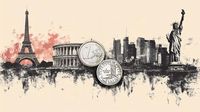As the dog days of August 2025 draw on, global financial markets are on edge, bracing for a one-two punch of high-stakes events that could reshape the economic and geopolitical landscape for months to come. The first is the closely watched Trump-Putin Summit, held on August 15 in Alaska, and the second is the Federal Reserve’s annual Jackson Hole Economic Symposium, set for August 21-23 in Wyoming. Each event carries its own set of risks and opportunities, but together, they promise to test the resilience of investors and policymakers alike.
The Trump-Putin Summit marked the first in-person meeting between President Donald Trump and Russian President Vladimir Putin since Trump’s return to the White House after the 2024 election. According to reporting from aInvest, the summit’s main focus was the ongoing Russia-Ukraine war. Trump’s campaign promise to bring the conflict to an end fueled speculation about possible ceasefire arrangements, humanitarian corridors, and even long-term security guarantees. Yet, the absence of Ukrainian President Volodymyr Zelenskyy from the initial talks raised eyebrows across Europe, with some fearing that a bilateral U.S.-Russia deal could sideline Ukrainian and broader European interests.
Historically, meetings between Trump and Putin have been market-moving events. The 2017 summit in Alaska, for example, coincided with a surge in U.S. shale production and a split in global oil prices. This year’s summit was no different, with investors watching every handshake and soundbite for clues on the direction of energy markets and risk premiums. As aInvest notes, a successful summit could stabilize crude oil prices and give a lift to Russian equities, while a breakdown in talks might send investors scrambling for the safety of gold and related exchange-traded funds (ETFs).
Adding to the complexity, Trump’s proposed U.S. tariffs—already priced into markets and projected to add two percentage points to inflation—loom over the proceedings. If the summit leads to a de-escalation in Ukraine, the inflationary impact of these tariffs could be partially offset by lower energy costs. But if tensions flare, the inflationary threat could intensify, putting even more pressure on the Federal Reserve as it heads into Jackson Hole.
Meanwhile, the U.S. economy is showing unmistakable signs of stagflation: sluggish growth paired with stubborn inflation. This makes the upcoming Jackson Hole symposium more consequential than ever. Central bankers from around the globe will gather in Wyoming to discuss inflation, interest rates, and global economic stability—topics that have rarely felt so urgent. Federal Reserve Chair Jerome Powell is scheduled to deliver his keynote address at 10 a.m. Eastern on Friday, August 22. According to CNBC, this speech could very well be the defining moment of Powell’s career, especially as his term as chair winds down with a May 2026 expiration.
Powell’s leadership and the Fed’s independence are under the microscope, not least because the Trump administration has made no secret of its desire for lower rates—and a new Fed chair. The administration is reportedly vetting 11 potential successors, including Wall Street figures who have publicly called for aggressive interest rate cuts. Trump, who nominated Powell in 2017, has been openly hostile in recent months, labeling Powell "TOO LATE" and "stupid" in a string of public criticisms.
Market participants are hanging on Powell’s every word, hoping for clarity on the Fed’s path for the rest of the year. There is rampant speculation about rate cuts, including a possible half-point cut as soon as September. The Russell 2000 index recently rallied more than 3%, and the equal-weight S&P 500 outperformed, driven by hopes that laggard sectors like healthcare—which climbed almost 5% this week—will benefit from easier monetary policy. But as Brian Leonard, portfolio manager at Keeley Gabelli Funds, told CNBC, "Will small-, mid-caps outperform large caps? That’s the question. We think there’s a possibility they do."
Yet, the risks are palpable. If Powell adopts a hawkish tone at Jackson Hole, he could "throw cold water on the market," especially as macroeconomic concerns persist. The S&P 500 is currently trading at a lofty 25 times forward earnings, making it vulnerable to any disappointment on the earnings or policy front. Investors are also bracing for seasonal weakness in August and September, historically choppy months for equities. Upcoming earnings reports from major retailers like Target and Walmart are expected to shed light on the health of consumer spending during the critical back-to-school season.
On the currency front, the U.S. dollar has been under pressure, with the Dollar Index (DXY) closing its second consecutive week in the red, falling below the 98.00 level amid speculation of further Fed rate cuts, according to FXStreet. Economic data releases are coming thick and fast: the NAHB Housing Market Index on August 18, Building Permits and Housing Starts on August 19, and the FOMC Minutes on August 20—all providing further context for the Fed’s deliberations at Jackson Hole.
Globally, the Jackson Hole symposium will coincide with a flurry of central bank meetings and economic data. The eurozone will see key releases on trade, inflation, and GDP, while the UK, Japan, and Australia will report their own critical indicators. The Bank of England, Reserve Bank of New Zealand, and Sweden’s Riksbank are all set to announce policy decisions in the same week, ensuring that markets will have no shortage of information to digest.
As for the investment implications, aInvest suggests a balanced approach: hedge against geopolitical risks with gold ETFs and defensive sectors, position for potential rate cuts by extending bond durations or favoring rate-sensitive sectors like real estate and financials, and keep an eye on emerging markets, which could benefit from more accommodative global policies. The Pictet Asset Management barometer, for example, highlights emerging markets as a bright spot, with equities and local bonds showing promise.
Ultimately, the interplay between the Trump-Putin summit and the Jackson Hole symposium will likely determine the trajectory of risk premiums, inflation expectations, and equity valuations in the months ahead. If the Alaska summit paves the way for peace in Ukraine, energy prices may stabilize, giving the Fed more flexibility to cut rates. If not, heightened geopolitical tension could force the Fed to keep rates higher for longer, potentially triggering a market correction.
With so much at stake, investors are advised to stay nimble and diversified, ready to pivot as events unfold. The coming weeks will test not only the mettle of policymakers but also the patience and adaptability of those who put their money at risk in an increasingly unpredictable world.





